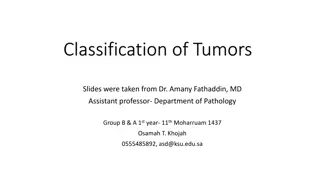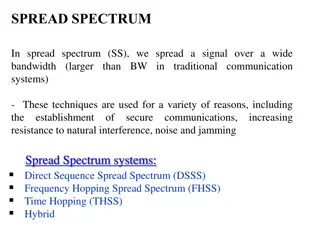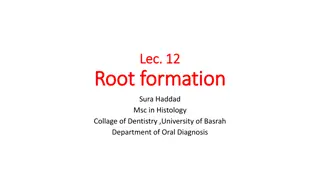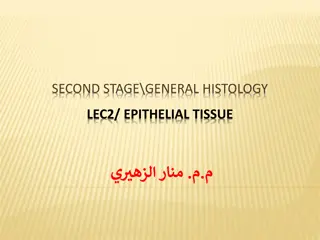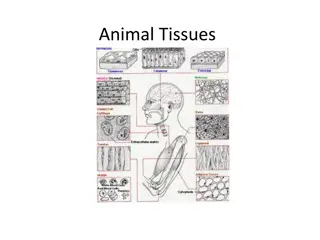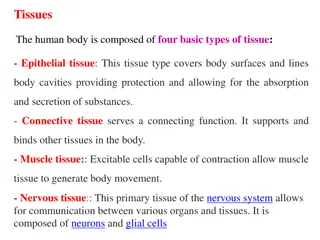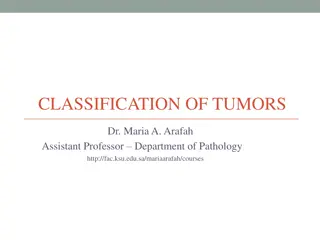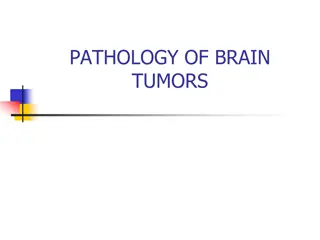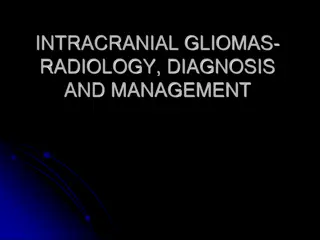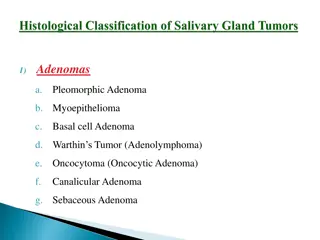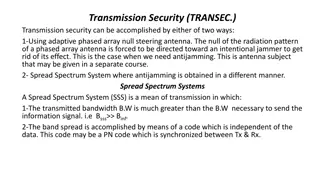Epithelial Tumors: Classification, Behavior, and Spread
Explore the classification, biological behavior, and spread of epithelial tumors including benign, precancerous, and malignant types. Learn about the microscopic features and spreading mechanisms of carcinomas. Discover the factors contributing to precancerous conditions and the common triggers leading to epithelial tissue damage.
Download Presentation

Please find below an Image/Link to download the presentation.
The content on the website is provided AS IS for your information and personal use only. It may not be sold, licensed, or shared on other websites without obtaining consent from the author.If you encounter any issues during the download, it is possible that the publisher has removed the file from their server.
You are allowed to download the files provided on this website for personal or commercial use, subject to the condition that they are used lawfully. All files are the property of their respective owners.
The content on the website is provided AS IS for your information and personal use only. It may not be sold, licensed, or shared on other websites without obtaining consent from the author.
E N D
Presentation Transcript
General oncology Epithelial tumors Neuroendocrine tumors
Classification of tumors 1. Epithelial tumors - surface epithelium/gland epithelium/special organs 1a. Neuroendocrine tumors 2. Mesenchimal tumors - Soft tissue/bones and cartilage/uncertain histog./undifferentiated 2a. Hematopoetic tumors 3. Neuroectodermal tumors 4. Germinal tumors
Biological behaviour of tumors Benign Precarcinous Malignant
Epithelial tumors Benign Malignant Surface epithelium papilloma carcinoma Glandular epithelium adenoma adenocarcinoma
Epithelial tumors lung (1.80 million deaths) breast (685 000 deaths) stomach (769 000 deaths) liver (830 000 deaths) colon and rectum (916 000 deaths)
Epithelial tumors. surface epithelium/gland epithelium/special organs Tumor or neoplasm Carcinoma versus cancer Macro: on surface or inside of organ. Type of growth exophytic or endophytic
Epithelial tumors. Microscopic features Can resemble epithelium it is arising from Can create characteristical product (mucin, keratin and etc.) With loss of differentiation lose resemblance to epithelium (dissociate) Sometimes can resemble sarcomas
Epithelial tumors Spreading of carcinomas - per continuitatem, hematogenic, lymphogenic Epithelial carcinomas the most commonly spread via lymphatics. Sentinel or guardian lymphatic nodule first place for mts Perineural spread can be common and dangerous for patient Spreading via serosa is called carcinosis or carcinomatosis For hematogenic mts the most common places are lung and liver
Precancers Etiologically anything can become a trigger. The most common triggers are UV light, chronic inflammation, smoking, red meat consuming, alcohol and etc. Molecular damaged population of epithelium dysplasia High-grade dysplasia carcinoma in situ Intraepithelial neoplasia low-grade, high-grade
Tumors from surface epithelium Distinguished are squamocelular and urothelial Benign form: papilloma Malignant form: carcinoma
Squamocelular papiloma HPV associated Finger like growing pattern Koilocytosis Types of growths exophytic and inverted
Precancers from squamous epithelium Nuclear atypia and varying degrees of cytoplasmic maturation Atypia is growing up from basal to superficial layers Damaged epithelium can keratinize At mucosa keratinization can look white (leucoplakia) If inflammatory reaction appears grossly we see red colour (erytroplakia) Solar keratosis is the most common skin precancer CIS Bowen disease
Basalioma Basalioma is made of undifferentiated cells, palisading on the periphery and the most structured in the center. Arise in sun exposed areas No mts, BUT local recurrence
Urothelial tumors Can be found everywhere in efferent urinary tract Most have papillary character Benign lesion urothelial papilloma Borderline lesion non- invazive papilar urothelial carcinoma Malignant lesion invasive papilar urothelial carcinoma
Tumors from glandular epithelium Benign adenoma Malignant adenocarcinoma Adenoma polypous tumor. Can be tubular, follicular, solid and etc. Adenomas are able to produce some function (sometimes even hyperfunction)
Progression of intestinal adenoma to adenocarcinoma
Adenocarcinoma has different structure according to level of differentiation
Tubular Solid Dissosiated
Other types of epithelial tumors Mixed tumors two or more parts in one tumor E.g.: carcinosarcoma, adenosarcoma, fibroadenoma In some locations we observe very bright tumors in salivary glands Warthin tumor, pleomorphic adenoma
Neuroendocrine tumors (NETs) are derived from the diffuse neuroendocrine system, which is made up of peptide- and amine-producing cells with different hormonal profiles depending on their site of origin.
The disperse neuroendocrine system DNS Substances may act as neurotransmitters, as true hormones, or as paracrine regulators.
The most recent World Health Organization 2010 recommendation for the general endocrine tumor classification includes: 1. Neuroendocrine tumor (NET), G1 or G2 2. Neuroendocrine carcinoma (NEC), G3, large cell or small cell type 3. Mixed neuroendocrine/non-neuroendocrine carcinoma (MiNEN)
MULTIPLE ENDOCRINE NEOPLASIA SYNDROMES MEN Features: autosomal dominant traits with a high degree of penetrance MEN 1 (MENIN): pituitary, pancreas, and parathyroid MEN 2A (RET): thyroid C cells, adrenal medulla, and parathyroid MEN 2B (RET): thyroid C cells, adrenal medulla, mucosal neuromas
IHC Diagnostics Typical NE markers: Chromogranin Synaptophysin CD 56 Hormone markers Gastrin, insulin, PP and etc Not typically done Proliferation marker Ki67
Neuroendocrine markers Synaptophysin is the principal structural element of the walls of synaptic vesicles and thus a neuroendocrine marker
Neuroendocrine markers CD56 is the cluster of differentiation assignment for the neural cell adhesion antigen
Carcinoid syndrome The main role is played by serotonine Systemic damage characterized by hot flashes, dermatitis, diarrhea, bronchoconstriction Special condition carcinoid heart
Neuroendocrine lung tumors Neuroendocrine tumors of the lung are subdivided into 4 major categories: 1) Small cell lung carcinoma (SCLC) strongly linked with cigarette smoking 2) Large cell neuroendocrine carcinoma (LCNEC) strongly linked with cigarette smoking 3) Atypical carcinoid (AC) non-smokers 40%, can be part of MEN 1 4) Typical carcinoid (TC) non-smokers 40%, can be part of MEN 1 SCLC and LCNEC are high-grade malignant tumors, AC is intermediate- grade, and TC is considered low-grade malignant tumor.
Small cell lung carcinoma Large cell neuroendocrine carcinoma
Small cell lung carcinoma Large cell neuroendocrine carcinoma
Typical carcinoid Nesting pattern
Chromogranin Synaptophysin CD56
Neuroendocrine GIT tumors Gastrointestinal neuroendocrine tumors (GI NETs) are a type of neuroendocrine tumor that develops within the GI tract, anywhere from the esophagus to the anus Synaptophysin
Case study A 10 y.o. boy complained of right lower quadrant abdominal pain. He also had a fever and leukocytemia. In hospital was performed an appendectomy.
Nests pattern Salt and pepper nuclei
Synaptophysin Chromogranin Ki 67


